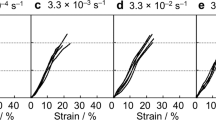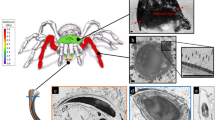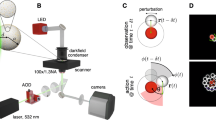The torsional properties of spider silk add to its list of remarkable physical credentials.
Abstract
The ductility and strength of spider draglines means that they outperform the best synthetic fibres1,2,3,4,5, but surprisingly little is known about the torsional properties of this remarkable filament. Unlike a mountain climber swinging from a rope, a spider suspended from its silk thread hardly ever twists. Here we show that a spider dragline has a torsional shape ‘memory’ in that it can reversibly and totally recover its initial form without any external stimulus; its observed relaxation dynamics indicate that these biological molecules have successively different torsional constants.
Similar content being viewed by others
Main
The torsion pendulum is the best tool for exploring the twist properties of threads because its period of oscillation does not depend on the amplitude of oscillation. In our experimental set-up, we used a small plastic or copper rod to represent the weight of the spider and suspended it from a 10-cm thread. The ‘spider’ rod was turned through about 90° and the dynamical responses of different suspending threads were registered by a camera linked to a computer.
When a thread of the synthetic organic polymer Kevlar is twisted from equilibrium, the rod oscillates gently around its original position. In this case, the response of the filament is elastic, with little energy dissipation (Fig. 1a): its oscillating behaviour is typical of a weakly damped, torsional pendulum.
Red arrows indicate the end of the excitation and the start of the free relaxation period. Blue dotted line, new equilibrium position. a, Kevlar thread (poly-p-phenylene terephthalamide) of diameter 10 µm; the suspended mass is 0.5 g and the torsional constant C is 10−1 N m rad−1. b, Copper thread of diameter 50 µm; the suspended mass is 2 g. c, Thread of the spider Araneus diadematus, drawn from a falling spider and handled carefully to avoid stretching; the suspended mass is 0.1 g. Inset: zoom of the start of the self-relaxation dynamics. d, Shape-memory Nitinol alloy thread of diameter 100 µm; the suspended mass is 3 g. The response of this thread is similar to that of spider dragline, but the alloy needs to be heated from 20 °C to 90 °C in order to relax to its original shape.
The torsional stability of a copper thread is greater after being twisted from its original rest position — the rod barely oscillates around its new (deformed) equilibrium position (Fig. 1b). The soft metallic copper thread, unlike the tough Kevlar filament, displays the strong damping typical of high energy dissipation6. The mechanical properties of the copper thread confer good torsional stability — its rigidity increases because of work-hardening due to dislocations, stopping it from easily untwisting. In fact, copper becomes brittle after few twists6.
Unlike either of these filaments, dragline silk from the spider Araneus diadematus (Fig. 2), when turned from its initial position, scarcely oscillates around the new pseudo-equilibrium position because of its high damping coefficient (Fig. 1c, inset). This response is independent of friction arising from resistance to the air. Unlike copper thread, spider silk retains its torsional qualities through several cycles. Also, the spider silk completely recovers its original position in what resembles an exponential manner (Fig. 1c). This requires the filament to exhibit a series of different torsional constants. The response sets spider silk apart from either Kevlar or copper.
We compared spider silk's response with that of a synthetic thread of ‘shape-memorizing’ nickel–titanium alloy (Nitinol), which is widely used in industry7. Like the spider dragline, the excited Nitinol thread weakly oscillates around an equilibrium position that differs from the original one (Fig. 1d). Its properties are due to a coherent diffusionless deformation of the shape-memory crystal without any dislocation8. However, Nitinol has to be heated to 90 °C to recover its original shape. By contrast, the spider has evolved a shape-memory material that needs no external stimulus for total recovery, even though it takes time.
Our results show that spider-dragline silk, in addition to its outstanding tensile strength and toughness, has unrivalled torsional qualities that stop the spider twisting and swinging. In view of the different torsional relaxations underlying the behaviour shown in Fig. 1c, testing the relaxation of spider-silk analogue proteins such as poly-L-alanine and poly-L-glycine could be warranted — to see whether reconstruction of sacrificial bonds forms the basis for the observed behaviour of silk. Tiny torque effects in other biological molecules such as DNA9,10 also wait to be unravelled.
References
Gosline, J. M., Denny, M. W. & DeMont, M. E. Nature 309, 551–552 (1984).
Lazaris, A. et al. Science 295, 472–476 (2002).
Jin, H. -J. & Kaplan, D. L. Nature 424, 1057–1061 (2003).
Craig, C. L. Spiderwebs and Silk (Oxford Univ. Press, New York, 2003).
Becker, N. et al. Nature Mater. 2, 278–283 (2003).
Feynman, R. P., Leighton, R. B. & Sands, M. The Feynman Lectures on Physics Vol. 2 (Addison–Wiley, London, 1964).
Ashley, S. Sci. Am. 289, 84–91 (2003).
Bhattacharya, K., Conti, S., Zanzotto, G. & Zimmer, J. Nature 428, 55–59 (2004).
Bryant, Z. et al. Nature 424, 338–341 (2003).
Koster, D. A., Croquette, V., Dekker, C., Shuman, S. & Dekker, N. H. Nature 434, 671–674 (2005).
Author information
Authors and Affiliations
Corresponding author
Ethics declarations
Competing interests
The authors declare no competing financial interests.
Rights and permissions
About this article
Cite this article
Emile, O., Le Floch, A. & Vollrath, F. Shape memory in spider draglines. Nature 440, 621 (2006). https://doi.org/10.1038/440621a
Received:
Accepted:
Published:
Issue Date:
DOI: https://doi.org/10.1038/440621a
This article is cited by
-
Aqueous spinning of robust, self-healable, and crack-resistant hydrogel microfibers enabled by hydrogen bond nanoconfinement
Nature Communications (2023)
-
Synthesis and characterization of a novel shape memory polymer
Journal of Polymer Research (2022)
-
Mechano-responsive hydrogen-bonding array of thermoplastic polyurethane elastomer captures both strength and self-healing
Nature Communications (2021)
-
Silkworm and spider silk electrospinning: a review
Environmental Chemistry Letters (2021)
-
Artificial spider silk from ion-doped and twisted core-sheath hydrogel fibres
Nature Communications (2019)
Comments
By submitting a comment you agree to abide by our Terms and Community Guidelines. If you find something abusive or that does not comply with our terms or guidelines please flag it as inappropriate.





